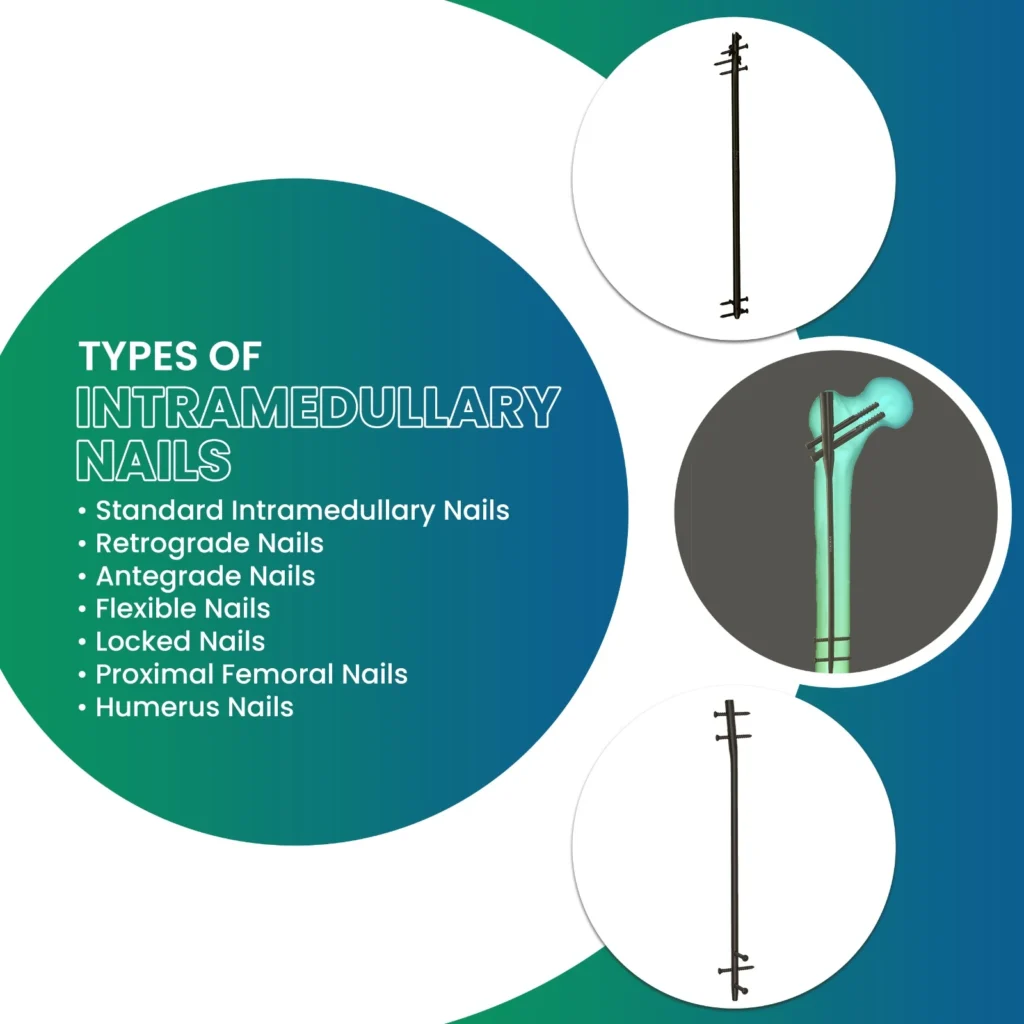Our range of an Intramedullary Nail?
An intramedullary nail, often referred to as an IM nail or simply a nail, is an orthopedic implant used to stabilize fractured long bones, particularly those in the femur and tibia. Surgeons insert the nail into the marrow canal of the bone, providing stability and alignment during the fracture treatment. This technique is particularly advantageous for fractures that require accurate reduction and for cases where external fixation might not be ideal.

Types of Intramedullary Nails
Intramedullary nails come in various designs and configurations, each tailored to specific anatomical considerations, fracture types, and patient needs. Let’s explore some of the common types of intramedullary nails used as orthopedic implant in surgery:
-
Standard Intramedullary Nails:
Interlocking nails are designed for straightforward fractures and are typically used in long bones like the femur and tibia. They consist of a straight or slightly curved rod with locking screws at both ends. Standard nails provide stability and alignment during the healing process.
-
Retrograde Nails:
Designers create retrograde nails for fractures near joints, such as the hip or shoulder. Inserting from the bottom of the bone and extending upward, the nails provide a different approach compared to insertion from the top.
-
Antegrade Nails:
Surgeons commonly use these nails to treat fractures in the long bones of children since they are more pliable and designed to accommodate the natural growth of bones. Medical professionals commonly use them for treating fractures in the femur and tibia.
-
Flexible Nails:
Flexible intramedullary nails are often used in pediatric patients with growing bones. Surgeons commonly use these nails to treat fractures in the long bones of children because they are more pliable and designed to accommodate the natural growth of bones.
-
Locked Nails:
Locked intramedullary nails have a locking mechanism that provides additional stability by securing the nail to the bone with screws at multiple points. This is particularly useful for complex fractures or cases where rotational stability is crucial.
-
Proximal Femoral Nails:
Interlocking nails are specifically designed for fractures in the proximal femur (hip region). They often have a unique shape to accommodate the anatomy of the hip joint and provide optimal stability.
-
Humerus Nails:
Intramedullary nails system designed for the humerus fractures (upper arm bone) are used to stabilize fractures in this area. They consider the unique anatomy of the humerus and provide support for fractures near the shoulder.
Materials Used in Intramedullary Nails System
Let’s delve into the materials commonly used in the manufacturing of Our range of intramedullary nails:
- Stainless Steel:
Stainless steel is a popular choice for intramedullary nails due to its high strength and durability. It provides rigid stabilization, making it suitable for fractures that require significant support. - Titanium and Titanium Alloys:
Titanium and its alloys, such as titanium-nickel or titanium-aluminum-vanadium, are widely used in modern orthopedic implants. Titanium offers excellent biocompatibility, which reduces the risk of adverse reactions within the body. - Cobalt-Chromium Alloys:
Cobalt-chromium alloys are known for their high strength, excellent wear resistance, and corrosion resistance. These characteristics make them suitable for intramedullary nail applications, especially in cases where the nail needs to withstand significant mechanical stresses. - Composite Materials:
Some intramedullary nails incorporate composite materials, which combine the strengths of different materials to create a tailored implant. These composites can consist of materials like carbon fiber-reinforced polymers or ceramic-reinforced polymers.
Choosing the Right Material
The choice of material for an intramedullary nail depends on several factors, including the type of fracture, the patient’s age and activity level, the bone’s load-bearing requirements, and the surgeon’s preferences. Titanium and its alloys are becoming increasingly popular due to their biocompatibility and favorable mechanical properties.
However, you should always consult with a skilled orthopedic surgeon who can assess the individual case and select the most appropriate nail material for the specific situation.
Benefits of Intramedullary Nails
Stability: One of the primary benefits of using an intramedullary nails system is the stability they provide to fractured bones. By maintaining alignment and allowing controlled weight-bearing, these nails promote quicker healing and reduce the risk of malunion or nonunion.
Minimal Soft Tissue Disruption: Unlike external fixation methods, intramedullary nails are inserted directly into the bone canal, minimizing damage to surrounding soft tissues. This reduces the risk of infection and speeds up the recovery process.
Early Mobilization: Interlocking nails allow for earlier weight-bearing and mobility compared to traditional casts. This can lead to improved patient outcomes, reduced muscle atrophy, and shorter hospital stays.
Fracture Alignment: IM nails aid in achieving and maintaining proper fracture alignment, which is crucial for optimal healing. They provide excellent support for fractures that are challenging to immobilize using external devices.
The Procedure of Implanting Intramedullary Nails System
The insertion of an intramedullary nail involves a surgical procedure that requires specialized training and equipment. Here’s a simplified overview of the process:
Preparation: The patient is positioned appropriately, and anesthesia is administered. Surgeons use X-rays or other imaging tools to guide the placement of the nail.
Incision and Nail Insertion: A small incision is made near the fracture site. The surgeon then drills a hole into the bone’s marrow canal and inserts the intramedullary nail.
Locking Mechanism: Some nails feature locking mechanisms that ensure the nail stays in place. You can insert these locks through small incisions or guide holes.
Closure: Once the nail is properly placed, the incisions are closed, and the surgical site is dressed.
Conclusion
Zealmax Ortho, a pioneering name in the field of orthopedic implants, takes pride in its cutting-edge our range of intramedullary nails. These innovative implants have redefined the landscape of fracture treatment and bone fixation, offering a blend of advanced technology, patient-centric design, and surgical precision.
At Zealmax Ortho, we understand the intricate nuances of orthopedic care and the paramount importance of swift, effective healing for patients. Our range of intramedullary nails reflects our unwavering commitment to excellence, both in craftsmanship and patient outcomes.

